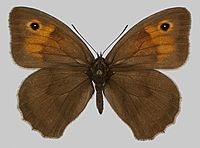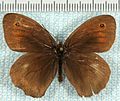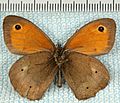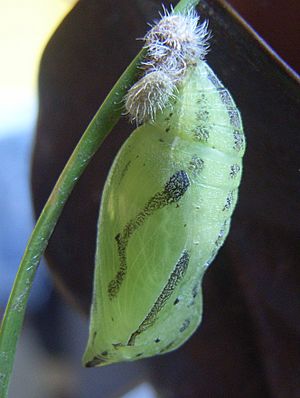Meadow brown facts for kids
Quick facts for kids Meadow brown |
|
|---|---|
 |
|
| Female | |
 |
|
| Mounted on a card | |
| Scientific classification | |
| Kingdom: | |
| Phylum: | |
| Class: | |
| Order: | |
| Family: | |
| Genus: |
Maniola
|
| Binomial name | |
| Maniola jurtina (Linnaeus, 1758)
|
|
The meadow brown (scientific name: Maniola jurtina) is a common butterfly. You can find it in meadows across Europe. Its young, called larvae or caterpillars, love to eat different kinds of grasses.
Contents
Appearance and Differences
Meadow brown butterflies show some cool differences between males and females. This is called sexual dimorphism.
Male vs. Female Butterflies
Male meadow browns are usually less colorful. They have smaller eyespots and less orange on their top front wings. Males are also very active and fly around a lot.
Female meadow browns tend to fly less. They often stay close to the area where they grew up.
Why Eyespots Are Important
The spots that look like eyes on the butterfly's wings are very important. These "eyespots" help protect the butterfly from predators. When a bird or other animal tries to attack, the eyespots trick them. The predator might aim for the spot instead of the butterfly's body. This helps the butterfly escape with only a small injury to its wing.
Food Plants
Meadow brown caterpillars enjoy eating several types of grass. These are their main food sources:
- Sheep's fescue (Festuca ovina)
- Rough meadow grass (Poa trivialis)
- Smooth meadow grass (Poa pratensis)
Life Cycle
The meadow brown butterfly goes through several stages in its life.
Eggs
The female butterfly lays her eggs on a blade of grass. The egg stands upright and has small ridges. The top is flat with a ring. When first laid, the egg is whitish-green. As it gets older, it turns brownish-yellow and might have purplish-brown marks.
Caterpillar (Larva)
The caterpillar is bright green. It has short, whitish hairs all over its body. A darker line runs down its back. There's also a white stripe on each side, above its reddish breathing holes (spiracles). The two points at the end of its body are white. Its head is a slightly darker green and also hairy.
Pupa (Chrysalis)
When the caterpillar is ready, it turns into a pupa, also called a chrysalis. The chrysalis is pale green. It has brownish marks on the parts that will become the butterfly's wings. The top part (thorax) has blackish spots. The points on its body are brownish. The chrysalis hangs upside down, often with the old caterpillar skin still attached.
Images for kids
-
Maniola jurtina female on buttercup flower.
See also
 In Spanish: Maniola jurtina para niños
In Spanish: Maniola jurtina para niños


















